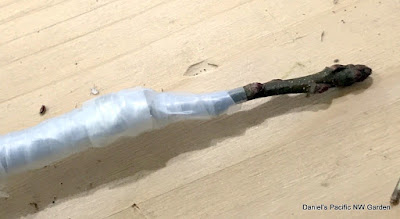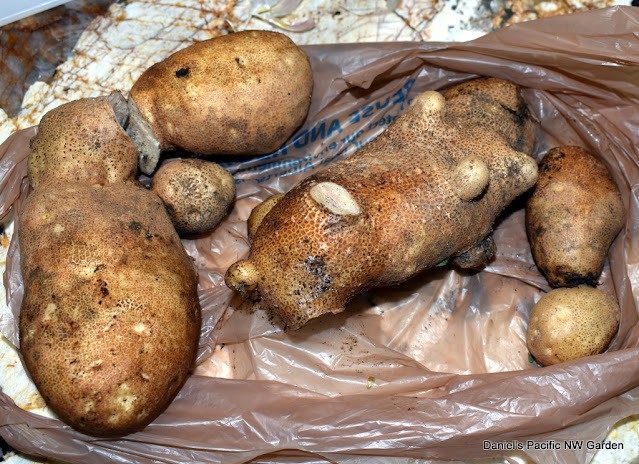Along with the apple grafts, I wanted to try some pear grafts. Again, this was for making miniature trees. However, I'm not aware of sources for miniaturizing pear trees. There are some less conventional ways. Serviceberry, Hawthorn, and Aronia are pear relatives, although different species. There is some info from the fruit growing hobby community that pear can grow with these as rootstocks. Also, the apple variety "Winter Banana" will reportedly accept apple scion, so I wanted to try that too.
I grafted European pear onto Winter Banana on a Bud-9 rootstock, and also onto an existing apple tree branch.
I grafted European pear onto two varieties of Serviceberry, and onto a Chinese Hawthorn and onto a Black Hawthorn.
I grafted Asian pear onto Aronia.
Nothing took on the Serviceberry.
The European pear did very well on Chinese Haw, growing about two feet. Here is the graft, a little irregular but it looks OK. That shoot is actually below the graft union, and is Hawthorn.
The graft on Winter Banana on Bud-9 did not grow. The graft on Black Hawthorn did not grow.
I lost track of the other two, because of location. Now, I started Fall cleanup as well as picking apples, and discovered the Asian Pear on Aronia. It didn't grow much, but then again (a) it took, and grew some and (b) it was buried in snowpeas and volunteer four o'clocks, and (c) it was not watered all summer long.
The European Pear on Winter Banana on an existing apple tree, did take and grew a little. Again, not a lot. I'm not sure what to do with this - I don't need a pear on an apple tree. I might try cutting the graft at the Winter Banana and graft that, with the already healed pear graft, onto Geneva 222 or Bud 9. Maybe the Pear/Apple graft needed more vigor to heal together, than the Bud-9 can provide but now that it did, it will grow.
Since these were sort of hidden and forgotten, I never got around to removing the graft binder ziplock strips. That's most likely fine, but I'll do that today.

















































